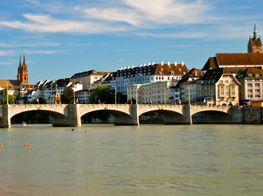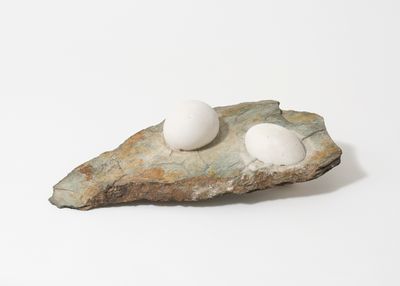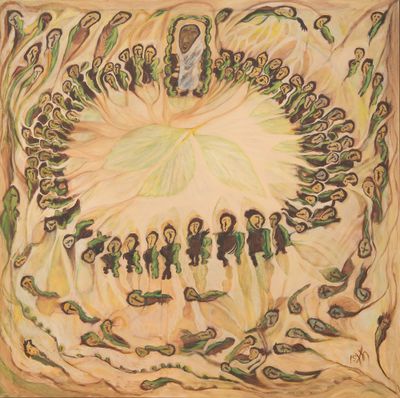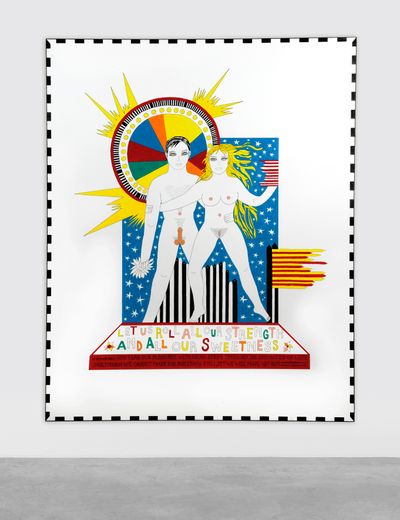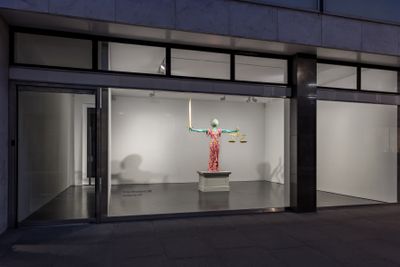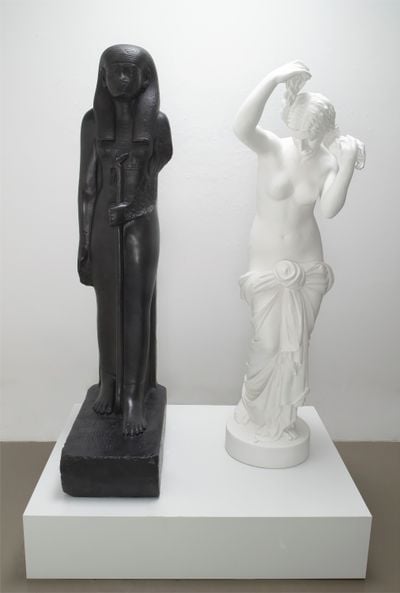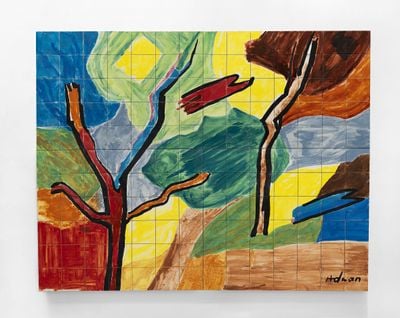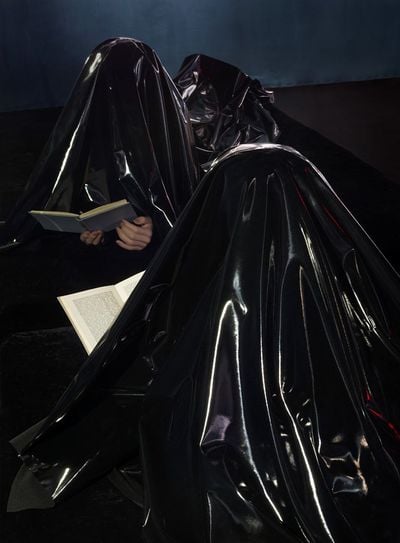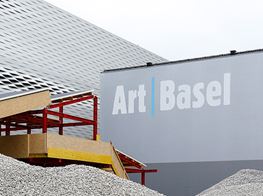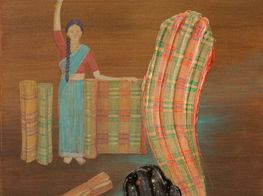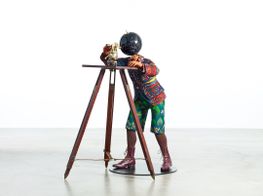Art Basel Viewing Rooms: Editorial Selections
Ocula Magazine's editors present their picks from Art Basel's Online Viewing Rooms, on view between 17 and 26 June 2020.
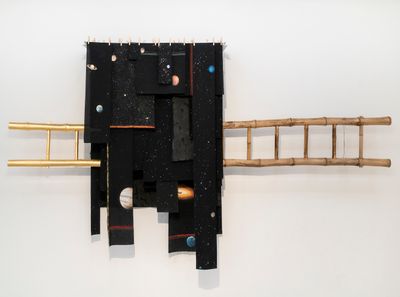
NS Harsha, Ascent or Descent to Reality (2018). Courtesy the artist and Chemould Prescott Road.
NS Harsha, Ascent or Descent to Reality (2018) at Chemould Prescott Road
NS Harsha's discordant compositions interrogate systems of knowledge, power, and belief. Reworking the tradition of Indian miniature painting, surfaces are filled with figures performing repeated actions, their seriality recalling the artist's childhood interest in comics. From afar, these detailed paintings resemble the cosmos. In Ascent or Descent to Reality (2018), however, the cosmos is actually depicted on dark pieces of cloth draped over a bamboo ladder hung horizontally—a composition drawn from observations of clothes drying on bamboo poles that extend from the windows of public housing estates in Hong Kong. (The work was shown in Harsha's first solo exhibition in the city at the Centre for Heritage, Arts and Textile in 2019.) One end of the ladder is wrapped in gold leaf, suggesting ascent might lead to 'absolute truth', yet the ladder's horizontality refutes hierarchical orders between above and below. TM
Lauren Halsey, Loda Land (2020) at David Kordansky Gallery
Loda Land (2020) is a seamlessly interlocking collage uniting a universe of images drawing on Black life in America, from Afrofuturist sphinxes, golden sarcophagi, and hot pink pyramids, to shop signs for braids and weaves, and the Funkadelic flag. Part of the collage forms the background for hand-carved gypsum wall works presented in the artist's online solo show with the gallery—a stunning series of minimalist ivory surfaces on which braided and shaved heads, or street signs coming together as text-based assemblages, are etched. The architectural nature of these panels connects to GalleryPlatform.LA, a structure first proposed as a large-scale prototype titled The Crenshaw District Hieroglyph Project, which won the Mohn Award as part of the Hammer Museum's biennial survey of L.A.-based art, Made in L.A., in 2018. A committed L.A. resident, Halsey recently raised USD $78,631 for the Summaeverythang Community Center, which the artist founded to distribute farm-direct produce to residents of South Central Los Angeles. SB
Maria Bartuszová, Untitled 16 (1984) at Alison Jacques Gallery
One of Slovakia's most important sculptors, Maria Bartuszová's fragile forms were first introduced to an international audience at Documenta 12 in 2007, 11 years after her death. Born in Prague in 1936, Bartuszová lived in relative isolation in Košice, where she relocated in 1963 upon graduating from Prague's Academy of Applied Arts, Architecture and Design in 1961. Having specialised in ceramics and porcelain, the artist gravitated to plaster in the 1960s, later employing a 'pneumatic shaping' practice that involved pouring plaster onto balloons that left negative spaces once they burst. Inspired by nature, ovoid forms, as seen in Untitled 16 (1984), became prominent in later work—symbols, Bartuszová said, 'of what is alive, soft, adaptable, as well as vulnerable and at risk'. Between 11 November 2020 and 18 April 2021, Tate Modern, in collaboration with Vienna's Belvedere 21, will host an exhibition of around 100 of the artist's works. The last significant exhibition of the artist's work took place in 2014 at Warsaw's Museum of Modern Art. TM
Kamala Ibrahim Ishag, Procession (the Zãr) (2015) at Stevenson
This oil painting reflects Kamala Ibrahim Ishag's longstanding interest in the zãr ceremony in Sudan—a trance-like performance enacted to rid possessed individuals from a demon or bad spirit. These ceremonies involve music, incense, and dancing and are mostly performed by women. To create these images, Ishag layers colours before outlining figures and forms, their surfaces agitated in the final phase to evoke the swooping movement of figures amidst sun, sand, and sky. Diamond-shaped heads relate to the artist's association with the Crystalist group, which Ishag founded in 1971 with Muhammad Hamid Shaddad and Nayla El Tayib in reaction to the male-dominated Khartoum School, which originated in the 1960s, and in which Ishag was herself a leading figure. In separating herself from the movement, Ishag and the Crystalists sought to embrace diversity and transparency, publishing a manifesto in 1978 that posits the universe as a 'crystal cube, transparent and changing according to the viewer's position.' TM
Dorothy Iannone, All Our Strength and All Our Sweetness (2019) at Air de Paris
Born in 1933, Dorothy Iannone's style feels ahead of its time, refreshingly unencumbered by its place in art and social history. Painted in acrylic, graphite, and India ink on wood, at a glance her works look as if they could've been drawn using the pencil and paint bucket tools on a desktop computer, but in fact her flat style, as disinterested in depth and perspective as William Blake's paintings, derives from her exploration of Hindu erotica, Japanese woodcuts, and Greek vases. Iannone gave up a fellowship to study a doctorate in English literature at Stanford when she married painter James Upham and moved to New York in 1958, but her work still speaks to her fascination with words. The work's text comes from the final couplets of Andrew Marvell's unsexy but urgent poem 'To His Coy Mistress' (1681): 'Let us roll all our strength and all / Our sweetness up into one ball, / And tear our pleasures with rough strife / Through the iron gates of life [...] Thus, though we cannot make our sun / Stand still, yet we will make him run.' SG
Iman Issa, Ian Law, Sidsel Meineche Hansen, Christodoulos Panayiotou, James Richards: Five Sound Works at Rodeo
Rodeo makes excellent use of the online art fair 'booth' to showcase five sound pieces, including James Richards' mesmerising choral tapestry Migratory Motor Complex, the central work in his 2017 Venice Biennale pavilion for Wales. Text-based posters introduce each composition, designed by Adrien Vasquez and available in editions of 200, with proceeds going to the Melissa Network, an organisation for migrant and refugee women in Greece. In the case of Iman Issa's The Revolutionary (2010), shown in Eungie Joo's 2012 New Museum Triennial, a fictional story—narrated in the work with text-to-speech software—is printed out. For Christodoulos Panayiotou's To Be Willing To March Into Hell for a Heavenly Cause, songs performed by Kristian Finne Kristensen on a boat going to Aegina island from the Athenian port of Piraeus—part of Disco Coppertone, curated by Locus Athens in 2007—are listed. In the audio recording, we hear numbers from Cold War-era American musicals, like 'Climb Every Mountain', their lyrics invoking nature to express wistful, defiant, and at times tragic hopes for better tomorrows. SB
Yinka Shonibare CBE, Justice for All (2019) at Stephen Friedman Gallery
When Stephen Friedman Gallery reopened its London space after lockdown, British-Nigerian Yinka Shonibare's Justice for All (2019) was situated where it could be seen from the street, the lights left on overnight so the statue could stand in solidarity with Black Lives Matter protests. The hand-painted fibreglass figure, modelled on F.W. Pomeryo's Lady Justice (1905–1906) standing outside London's Central Criminal Court, is dressed in Dutch wax prints, a trademark of the artist due to its associations with imperialism. In the 19th century, Dutch textile manufacturers copied batik fabrics found in Indonesia, then known as the Dutch East Indies, which were brought back to Africa by Ghanaian soldiers serving in the Royal Netherlands East Indies Army. Justice for All was created for an exhibition at The Arts House in Singapore, which inhabits a building rented by British colonial authorities in 1827 for use as a courthouse. Shonibare is not surprised that the work speaks to events taking place now. 'Some of these issues I've explored in my work have been going on for 30 years,' he said. SG
Florian Maier-Aichen, Untitled (Sunset #3) (2019) at Blum & Poe
Florian Maier-Aichen combines digital and analogue techniques to create otherworldly and deviously persuasive landscapes, a practice befitting of the artist's adopted home, Los Angeles. Though harking back to early photographers who used multiple exposures to improve an image, Maier-Aichen's process is as idiosyncratic as his education, which began at the Högskolan for Fotografi och Film in Gothenburg, Sweden, and continued at the University of Essen in Germany and the University of California in L.A. Among his tricks are digital scribbles rendered by hand, hand-painted cardboard foregrounds seamlessly blended into photographs, and photographs shot using an archaic tri-colour process that requires separate exposures of red, green, and blue, as seen in Untitled (Sunset #3). The subject of the work is not merely the fantasy-augmented Los Angeles they depict, but the tools Maier-Aichen uses to depict them. The 'Lasso Paintings', for instance, are named after the Photoshop tool he uses as a brush, with its own cyborg, gestural properties. SG
Fred Wilson, The Mete of the Muse (2006) at Pace Gallery
Upending white-washed histories defines Fred Wilson's practice. His seminal 1992 project Mining the Museum remixed objects from the Maryland Historical Society's collection into damning juxtapositions: a KKK robe placed inside a baby's pram, for instance, or a light shining on a slave in an 18th-century portrait of a white squire. Illuminations continued at the 2003 Venice Biennale, where Wilson spotlighted black figures in Venetian Renaissance paintings in the U.S. Pavilion, and again at the 15th Istanbul Biennial in 2017, where blown-up portraits of Africans found in Ottoman-era paintings hung alongside the originals. The Mete of the Muse is a pair of painted bronze casts of plaster sculptures found in an antique store and sculpture studio producing decorations for gardens and homes: one Egyptian, the other Greco-Roman. 'They were opposites, but had similarities,' Wilson explained. The title refers to the meaning of 'mete', to measure. 'Finding the exact distance apart was the most important creative act I could do', Wilson said of the piece. SB
Etel Adnan, Morning (2019) at Galerie Lelong & Co.
The title of Galerie Lelong & Co.'s presentation, An Unexpected Spring, comes from a book of interviews published by the gallery with philosopher, poet, playwright, and painter Etel Adnan, who relates 'an unexpected spring' to the 'mystery of poetic creation'. Morning (2019) reflects the artist's signature application of paint using a palette knife to direct swathes of colour that build landscapes. Adnan's ceramics have been in part inspired by Juan O'Gorman's mosaic murals at UNAM Central Library in Mexico City in 1957; she returned to this inspiration in 2013, creating two ceramic murals for Qatar University. Further ceramic compositions include the 35-metre-long Le soleil amoureux de la lune (2014), reflecting the lunar and solar cycles in bright, abstract shapes presented at Galleria Continua's space, Le Moulin de Sainte-Marie; with two similarly monumental pieces created for Etel Adnan In All Her Dimensions at Qatar's Mathaf: Arab Museum of Modern Art in 2014, which was followed by the artist's first U.K. solo exhibition at the Serpentine Sackler Gallery in 2016. TM
Irena Haiduk, How To Surround Your Self With Things In The Right Way, at Galerie Max Mayer
Irena Haiduk established Yugoexport after interviewing Srđa Popović, a student movement leader who helped depose Milošević in 2000. (The talk's recorded re-staging formed Seductive Exacting Realism, or SER, commissioned by Chicago's Renaissance Society and shown concurrently at the 14th Istanbul Biennial in 2015.) Popović founded the Center for Applied Nonviolent Action and Strategies in 2003 to train pro-democracy activists worldwide. Counting the U.S. Government and Lockheed Martin among its clients, Haiduk considers CANVAS 'a work of art in the Western sense, because it is useless'—the revolutions it helped foment often left countries vulnerable to predatory top-down capitalism. Yugoexport is thus modelled after a self-managed factory, producing things like Nine Hour Delay: shoes guaranteeing nine hours of standing comfort created for female documenta 14 workers, where SER was expanded. These shoes are for sale, among other products, according to an income-based sliding scale on Yugoexport's website, which was to be staged as a physical site of transaction inside Art Basel's Features sector. Unable to translate these plans into the digital realm, a thorough introduction to the brand's output is presented instead. SB—[O]

